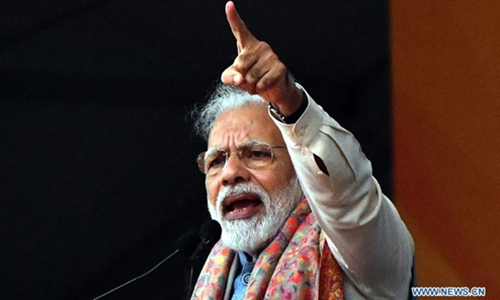COMMENTS / EXPERT ASSESSMENT
What factors are holding back economic growth of India?

File photo
Major global credit rating agencies Fitch Ratings, S&P Global Ratings and Moody's have all trimmed their sovereign ratings for India to the lowest investment grade. S&P expects the Indian economy to shrink by 5 percent in the current fiscal year. Even as COVID-19 rampages across the country, India has ended its nationwide lockdown, severely troubling its economy.The coronavirus has dealt a heavy blow to the Indian economy, but the economic downturn can't simply be attributed to the pandemic. It has just further exposed the inherent vulnerability of the economy.
Since being sworn in 2014, Indian Prime Minister Narendra Modi has held high the banner of economic development and brought out the ambitious "Make in India" initiative to boost the country's manufacturing sector.
However, though Modi has made some breakthroughs in tax reform and other areas, economic growth has not exceeded the level reached by the previous government. This is because restricting factors that hinder India's growth have not fundamentally changed, and India does not yet have the conditions to achieve sustainable and rapid economic growth.
India's backward basic infrastructure holding back growth has not been changed. Advanced infrastructure is the fundamental of economic development, especially for the manufacturing industry. Although several Indian governments have stressed the importance of infrastructure, decreasing progress has been achieved. India's railways, highways and power stations are still not sufficiently advanced.
India often puts politics above its economy, and attempts to reach political goals through economic means. Industrial and production capacity transfers from China would have promoted the "Make in India" initiative, but India has blocked such transfers for political purposes.
Recently, due to the China-India border dispute, some Indian groups have once again begun promoting a boycott of Chinese products. The state government of Maharashtra, home to the Indian city of Mumbai, said on June 22 that it had put on hold three investment proposals from Chinese firms worth 50 billion rupees ($658 million) in total. Such an irrational approach has affected foreign companies' willingness to make investments in India.
In addition, India is not good at balancing short-term and long-term interests. Take the Regional Comprehensive Economic Partnership (RCEP) as an example. Joining the RCEP would help India integrate into the Asian industrial and value chains, and help other Asian countries transfer industrial capacity to India. However, due to opposition from some Indian consortiums and local governments, the Modi government withdrew from RCEP negotiations.
India has not prepared to fully integrate with the global economy. In the era of globalization, giving full play to India's comparative advantages and integrating into the world would help the country achieve economic growth, but Indian society is wary of openness.
Indian government pretends to welcome foreign investments while setting up many obstacles.
Lowering tariffs and promoting trade facilitation would actually help India participate in international cooperation. India was aiming to protect its domestic enterprises through high tariffs, but the result clearly shows Indian enterprises are lacking international competitiveness.
The author is a senior research fellow of the Academy of Regional and Global Governance at the Beijing Foreign Studies University and president of the Chengdu Institute of World Affairs. bizopinion@globaltimes.com.cn



